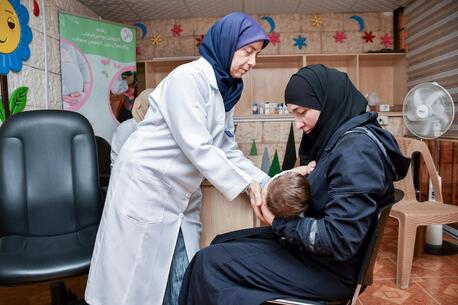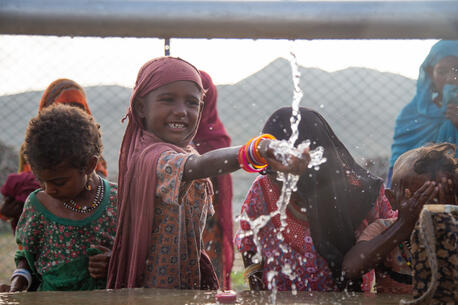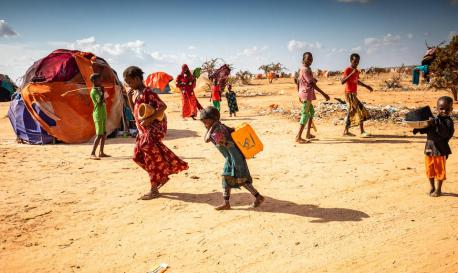
Years of Drought Pushing Families to the Brink in Ethiopia
UNICEF is working closely with local authorities to provide lifesaving assistance to families desperately in need as a severe drought takes hold.
For two straight years, the rain has refused to fall in Ethiopia. Water wells are dry; crops and livestock are dead and dying. In the lowland regions — Afar, Oromia, The Southern Nations, Nationalities, and Peoples’ Region (SNNPR) and Somali — drinking water is in short supply and food security is deteriorating rapidly.
Ethiopia's worst drought — part of a region-wide climate-induced crisis in the Horn of Africa, the worst in 40 years — has pushed families to the brink.
"The impact of the drought on children is devastating," said Manuel Fontaine, UNICEF Director of Emergency Operations. "Drought not only means lack of water. It means that children are going hungry and thirsty every day."
Often, children have no other option than to drink from contaminated water sources, Fontaine added. "This leads to malnutrition and killer preventable diseases like diarrhea."
Malnutrition rates increasing at an alarming rate in Ethiopia and across the Horn of Africa
Malnutrition rates among children in Ethiopia are increasing at an alarming rate due to the drought. UNICEF estimates that as many as 600,000 children will require treatment for severe acute malnutrition by the end of the year across Ethiopia's four drought-impacted regions.
"This climate-induced crisis is a malnutrition crisis for children and not just in Ethiopia but across Africa," Fontaine said.

In Gebi’as village, Somali region, Ethiopia, sixth grader Abdurazak Mohammed takes his donkeys back home, past the bodies of animals dead from thirst and starvation. His school is now closed due to the drought. “Many families sent their children with their cattle," he said. "The teachers also left. Then the school is closed. I feel sad to see my school closed. I want to be a teacher when I grow up.” © UNICEF/UN0583950/
Livestock are dying in the fields
Cows, sheep, goats, camels and donkeys are dying in the fields from the lack of food and water. For many, losing livestock means losing their livelihoods.
The situation has triggered a wave of displacement out of affected areas. In Somali region alone, more than 900,000 people have been displaced.
Just one month into the long dry season (Jilaal), Hafsa Bedel of Sagalo village, in Kebridahar woreda of Ethiopia's Somali region, had already lost 25 goats and sheep and four camels.
"There is no pasture, and our animals are suffering," said the mother of six. "I can’t afford to feed them corn. We don’t even have enough for us.”
Bedel is struggling to save the lives of her family's remaining camels, keeping them close to home so that her husband can bring water from a birkah (water well) where the government rations water. “If I let [the camels] go, they wouldn’t find food and water," she said. "They are still young.”

Women and children walk past animal carcasses in Sagalo village, Somali region, Ethiopia, as strong wind blows dust everywhere. © UNICEF/UN0583942
Children are dropping out of school to look for water
In Somali and Oromia, two of the hardest hit regions, dust is everywhere. More than 155,000 children in Somali and Oromia have dropped out of school so they can help fetch water — often traveling long distances — or look after other children while their caregivers try to find water for their families and cattle.
Children who are out of school are at risk of exploitation as families are pushed into dangerous coping mechanisms.
Ten-year-old Bukhari Aden has never been to school. He spends his days looking after his family's camels and fetching water. “In our village, the children are responsible to look after the animals," he explained. "There is no water near the village. If we had water available nearby, it would be easy for me to go to school.”

10-year-old Bukhari Aden runs after his family's camels after the animals find water near Beda’as kebele, Shebele zone in the Somali region of Ethiopia. © UNICEF/UN0583967
UNICEF is working with local authorities to provide lifesaving assistance to children and families
UNICEF is working in close coordination with local authorities to to reach children and families in drought-impacted regions of Ethiopia with urgently needed support, including treating severely malnourished children with Ready-to-Use Therapeutic Food (RUTF) and improving access to safe water, sanitation and hygiene services.
Priority efforts also include:
- rehabilitating water systems and boreholes to ensure access to safe water for communities affected by drought
- dispatching emergency water trucks and providing water for livestock
- distributing vitamin A supplements
- procuring and distributing emergency medicines and midwifery kits
- scaling up deployment of mobile health and nutrition teams and rehabilitating health centers
- providing emergency education, supporting the reopening of schools and providing learning supplies
- scaling up child protection services, particularly for children who are not in school

A nurse measures 2-year-old Nimo Abdi Dhuh's arm circumference with a pediatric MUAC (Mid-Upper Arm Circumference) bracelet. Nimo is receiving treatment for malnutrition at a UNICEF-supported mobile clinic in Barare village, Higloley Woreda, Somali, Ethiopia. © UNICEF/UN0583940/
At a UNICEF-supported mobile health clinic in Barare village, Higloley woreda, Somali region, Shamis Dhire looks on as a nurse measures her 2-year-old daughter's mid-upper arm circumference. She is being treated for malnutrition.
"My child is sick due to lack of milk and food, and this happened because of the drought," Dhire said. "Here, she has been given medical treatment. People have been harmed by the drought; our neighbors are affected the same way. Our cattle have been harmed by the drought. We have lost so much ... We pray to Allah for rain.”
We have lost so much ... We pray to Allah for rain.
UNICEF is appealing for support to help scale its emergency response in Ethiopia and across the Horn of Africa. Please donate today.
Top photo: In Ethiopia's drought-stricken Somali region, Hafsa Bedel is trying to keep her family's camels alive. The mother of six has already lost 25 goats and sheep; with little access to food or water, she fears that she will lose more livestock in the coming months, jeopardizing her family's livelihood and survival. © UNICEF/UN0583934/
HOW TO HELP
There are many ways to make a difference
War, famine, poverty, natural disasters — threats to the world's children keep coming. But UNICEF won't stop working to keep children healthy and safe.
UNICEF works in over 190 countries and territories — more places than any other children's organization. UNICEF has the world's largest humanitarian warehouse and, when disaster strikes, can get supplies almost anywhere within 72 hours. Constantly innovating, always advocating for a better world for children, UNICEF works to ensure that every child can grow up healthy, educated, protected and respected.
Would you like to help give all children the opportunity to reach their full potential? There are many ways to get involved.





